

An encyclopedia of Middle-earth and Numenor

|
|
|
|
|
|
|
|
|
|
|
|
|
|
| |
|
 |

An encyclopedia of Middle-earth and Numenor |
 |

For edible plants see Food
& Drink
Aeglos grew on the lower slopes of Amon Rudh in Beleriand, which was destroyed at the end of the First Age. Other locations where aeglos may have grown are not known.
Names &
Etymology:
The name aeglos means "snow-point"
or "icicle." The element aeg means "point" from ayak meaning
"sharp, pointed." The element los means "snow." The spear of Gil-galad
was also named Aeglos.
Sources:
Unfinished
Tales: "Narn I Hin Hurin," p. 99, 148 notes 14 and 15
The Children
of Hurin: "Of Mim the Dwarf," p. 128
The Silmarillion:
"Appendix - Elements in Quenya and Sindarin Names," entry for los
The History
of Middle-earth, vol. V, The Lost Road and Other Writings: "The Etymologies,"
entries for AYAK
In Unfinished Tales, a flower named alfirin is mentioned in the tale of "Cirion and Eorl," but there it appears to be a white flower reminiscent of Evermind or simbelmyne. See the entry for simbelmyne below.
Names &
Etymology:
Alfirin means "immortal."
Sources:
The Return
of the King: "The Last Debate," p. 151
The Letters
of J.R.R. Tolkien: Letter #312
Athelas |
Athelas
from the New Line film
|
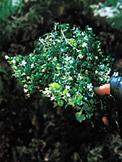 Plant
with healing properties. The athelas plant had long leaves that gave off
a sweet and pungent fragrance. The scent had a refreshing and envigorating
effect on those who inhaled it.
Plant
with healing properties. The athelas plant had long leaves that gave off
a sweet and pungent fragrance. The scent had a refreshing and envigorating
effect on those who inhaled it.
Athelas could be used to ease pain, and it also had the power to counteract the effects of the Black Breath exuded by the Nazgul. Only in the hands of a King of the line of Elendil could the full power of athelas be released.
Athelas may have grown in the Forest of Brethil in Beleriand. In 466 of the First Age, Huan the Hound gave Luthien a plant with healing properties to help Beren, who had been struck by an arrow. According to one source (HoME III, p. 269), it was athelas. Beleriand was destroyed at the end of the First Age.
In the Second Age, athelas was brought to Middle-earth from Numenor. It could be found growing in places where the Numenoreans and their descendants used to dwell or camp, including the area around Weathertop and the woods of Lossarnach in Gondor.
Aragorn used the athelas plant to help ease the pain of Frodo's Morgul-wound after the Lord of the Nazgul attacked him on Weathertop. He crushed the leaves into boiling water and bathed Frodo's shoulder. Frodo felt the pain and cold lessen, but the athelas could not cure him since there was still a sliver of the Morgul-knife in his body that had to be removed by Elrond. When Frodo and Sam were injured during the battle in Moria, Aragorn used what remained of the athelas he had gathered on Weathertop to treat their wounds.
After the Battle of the Pelennor Fields, Eowyn, Faramir and Merry were all gravely ill as a result of their contact with the Nazgul. In the Houses of Healing, Aragorn asked for athelas. The wise-woman Ioreth recognized the plant by its common name kingsfoil, but the herb-master said he had none since it had no virtue that he knew of, except as mentioned in an old rhyme:
When the black breath blowsAt last six leaves were found, and Aragorn crushed two leaves into steaming water for each patient. As he did so, a freshness filled the room, each time evoking a different feeling to those present, and the patients awoke.
and death's shadow grows
and all lights pass,
come athelas! come athelas!
Life to the dying
In the king's hand lying!
The Return of the King: "The Houses of Healing," p. 141
Names &
Etymology:
Athelas was called kingsfoil
in the Common Speech and asëa aranion in Quenya. The name kingsfoil
means
"king's leaf."
The Sindarin name athelas and the Quenya name asëa aranion are of uncertain etymology. The element las in athelas means "leaf" and the word aranion in asëa aranion means "of the kings."
The first elements in both names appear to be related but the meaning is uncertain. Asëa could be derived from the Quenay lassë meaning "leaf" so that asëa aranion would mean "leaf of the kings." But if the Sindarin athea had a similar meaning then athelas would mean "leaf leaf."
Alternatively, asëa and athea may be derived from the root athaya meaning "beneficial, helpful." In this case both names would mean "beneficial [leaf] of the kings" where the word for "leaf" is not included but implied. There is an Old English word aethel (æðele) meaning "noble" which may have been the original inspiration for the name. (Tolkien Language List)
Sources:
The Fellowship
of the Ring: "Flight to the Ford," p. 210-11; "Lothlorien," p. 350
The Return
of the King: "The Houses of Healing," passim
Tolkien
Language List
Bright's
Old English Glossary
When Numenor was created at the beginning of the Second Age, the Elves of Tol Eressea gave a seedling of Celeborn to the Numenoreans. The seedling was planted in the King's Court in Armenelos and it grew into a tree called Nimloth. When Numenor was destroyed in 3319, a seedling of Nimloth was rescued and was taken to Middle-earth where it became the White Tree of Gondor.
Names &
Etymology:
The name Celeborn means "silver
tree" from celeb meaning "silver" and orn meaning "tree."
There was also an Elf named Celeborn whose
name was interpreted as "silver-tall."
Sources:
The Silmarillion:
"Of Eldamar," p. 59; "Akallabeth," p. 263; "Appendix - Elements in Quenya
and Sindarin Names," entries for celeb and orn
Unfinished
Tales: "The History of Galadriel and Celeborn," p. 266
Elanor |
Elanor
and niphredil on Cerin Amroth by Alan Lee
|
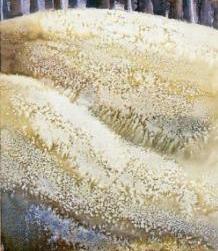 Flower
of Lothlorien and Tol
Eressea. Elanor was a small, golden, star-shaped flower. Elves from
Tol Eressea in the Undying Lands brought elanor to the wedding of Aldarion
and Erendis in Numenor
in 870 of the Second Age.
Flower
of Lothlorien and Tol
Eressea. Elanor was a small, golden, star-shaped flower. Elves from
Tol Eressea in the Undying Lands brought elanor to the wedding of Aldarion
and Erendis in Numenor
in 870 of the Second Age.
Elanor grew on the slopes of Cerin Amroth in the heart of Lorien. Aragorn and Arwen plighted their troth on Cerin Amroth among the elanor and niphredil, and when Aragorn returned to Lothlorien as a member of the Fellowship in January 3019 of the Third Age, he held a blossom of elanor as he remembered his time with Arwen, saying, "Arwen vanimelda, namarië!"
Sam Gamgee named his first daughter Elanor. It was customary to name Hobbit-lasses after flowers, and Sam chose Elanor at Frodo's suggestion because of his daughter's beauty.
Names &
Etymology:
Elanor is composed of el
meaning "star" and anor meaning "sun." Also called the sun-star.
Sources:
The Fellowship
of the Ring: "Lothlorien," 364-67
The Return
of the King: "The Grey Havens," p. 306
Appendix
A of The Lord of the Rings: "The Tale of Aragorn and Arwen," p. 341
Unfinished
Tales: "Aldarion and Erendis," p. 189, 216 note 20; Index, p. 432
In 465 of the First Age, King Thingol of Doriath had a wooden house built high in the branches of Hirilorn. He imprisoned his daughter Luthien there to prevent her from trying to rescue Beren who was being held captive by Sauron. He chose to house her in a tree so she could still see the lights of the Sun, Moon, and stars. The ladders were removed and the tree was guarded and supplies were brought to Luthien periodically.
Luthien used her arts to grow her hair long and from it she made a shadowy cloak and a rope that were enchanted with a spell of sleep. She let down the rope and the guards fell asleep. Luthien descended from Hirilorn and went to free Beren from captivity.
Beren and Luthien stole a Silmaril from Morgoth but Beren was mortally wounded by Carcaroth, the Wolf of Angband. He died at the foot of Hirilorn, though with Luthien's help he later returned to Middle-earth to live again for a time.
Names &
Etymology:
The name Hírilorn
means "Tree of the Lady" in Sindarin from híril meaning "lady"
and orn meaning "tree." Hírilorn may also have been called
Neldoreth
which was later applied to the whole forest. The word
neldor is
interpreted as "beech" but is derived from neled meaning "three"
and orn meaning "tree" in reference to Hirilorn's three trunks.
Sources:
The Silmarillion:
"Of Beren and Luthien," p. 172, 186; Index, entry for Neldoreth;
"Appendix - Elements in Quenya and Sindarin Names," entries for heru
and orn
Unfinished
Tales: "Narn I Hin Hurin," p. 78
The History
of Middle-earth, vol. V, The Lost Road and Other Writings: "The Etymologies,"
entry for NEL
Huorns |
A
Huorn in the New Line film
|
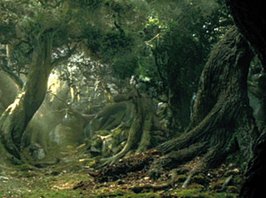 Trees
- or treelike beings - that could walk and speak. Huorns were powerful,
wild, and dangerous. The origin of Huorns is somewhat mysterious. Merry
Brandybuck speculated that Huorns were Ents that had become more like
trees. Treebeard also spoke of trees that
had become Entish, so it is possible that some of these became Huorns as
well.
Trees
- or treelike beings - that could walk and speak. Huorns were powerful,
wild, and dangerous. The origin of Huorns is somewhat mysterious. Merry
Brandybuck speculated that Huorns were Ents that had become more like
trees. Treebeard also spoke of trees that
had become Entish, so it is possible that some of these became Huorns as
well.
Huorns looked like trees, though they were strange in appearance, with twisted roots and long, grasping branches. They generally stood at rest, keeping watch over the ordinary trees. But when roused by a threat to the forest, Huorns could move swiftly and kill efficiently. It was difficult to see them move, for they seemed to be wrapped in shadow and they would appear as if out of nowhere. Huorns were able to speak with the Ents, and other people could hear the Huorns' voices murmuring through their branches.
Fangorn Forest was the home of many Huorns. Some of the Huorns stood on the eaves of the woods or scattered among the ordinary trees. There were also hundreds of Huorns in dark patches deep in the forest. Huorns could be dangerous to intruders, particularly to Orcs who wantonly cut down and destroyed trees.
During the War of the Ring, a great number of Huorns accompanied the Last March of the Ents to Isengard on March 2, 3019 of the Third Age. At midnight, Saruman's army left Isengard and headed to Helm's Deep, and many of the Huorns followed them. Others remained with the Ents and formed a ring around Isengard. Some of the Huorns helped the Ents gather the waters of the River Isen in order to flood Isengard. When Gandalf arrived on the night of March 3 seeking help, Treebeard sent hundreds more of the Huorns to Helm's Deep.
At Helm's Deep, the Huorns filled the Deeping-coomb, and it seemed as if a forest had grown there overnight. At dawn on March 4, King Theoden led a charge from the Hornburg, and Gandalf and Erkenbrand brought reinforcements down the western side of the valley. Saruman's army found their line of retreat cut off by the Huorns. The Orcs fled into the forest and the Huorns killed every last one of them.
The next night, the Huorns buried the Orcs that had been slain by the Rohirrim during the Battle of Helm's Deep in a great mound called the Death Down. The Orcs that had disappeared into the Huorn-wood after the battle may also have been buried there, though no one ever investigated the grave closely. The Huorns passed the camp of the Rohirrim on the Isen like a cloud of darkness and they returned to Isengard and then to Fangorn Forest. "Thus they were revenged upon the Orcs." (TTT, p. 158)
Names &
Etymology:
The name Huorn apparently
has something to do with the Huorns' ability to speak. According to Pippin,
"They still have voices, and can speak with the Ents -- that is why they
are called Huorns, Treebeard says." (TTT,
p. 170)
The word orn means "tree" but the meaning of the element hu is not clear. It may be related to hûn meaning "heart" or hûr meaning "readiness for action, vigor, fiery spirit." "Active tree" would be a suitable definition, though it does not specifically address the Huorns' speech capability.
Another possible derivation of hu is from the root KHUG meaning "bark" (the noise a dog makes, not the skin of a tree) or "bay" (like a hound). This element is found in the name of Huan the Hound. According to The Lord of the Rings: A Reader's Companion this definition "appears to be supported by unpublished etymological notes by Tolkien," but this is not further explained.
The three earlier names Tolkien used - Galbedirs, Lamorni, and Ornomi - all meant "talking trees." Galbedir is derived from the stem galad meaning "tree" and bedir a form of pedir possibly meaning "speaker" from the stem pet - "say." Lamorni contains lam meaning "sound" and orni meaning "trees." Ornómi - translated as "trees with voices" (HoME VIII, p. 55) - contains orne meaning "tree" and ómi from óma meaning "voice." An alternate version was spelled Ornómar.
Sources:
The Two
Towers: "Treebeard," p. 71, 90; "Helm's Deep," p. 146-47; "The Road
to Isengard," p. 148-55, 158; "Flotsam and Jetsam," p. 170-76
The Return
of the King: "The Passing of the Grey Company," p. 50
The History
of Middle-earth, vol. V, The Lost Road and Other Writings: "The Etymologies,"
entries for GALAD, KHO-N, KHOR, KHUGAN, KWET (PET), LAM, OM, ORO
The History
of Middle-earth, vol. VIII, The War of the Ring: "Flotsam and Jetsam,"
p. 47, 50, 55-56, 59 note 11, 59-60 note 15; Index entries for Galbedirs,
Lamorni, and Ornomi (defined as "Talking Trees")
The Lord
of the Rings: A Reader's Companion by Wayne G. Hammond and Christina
Scull: "Flotsam and Jetsam," p. 425
Lambengolmor
Names &
Etymology:
The name lairelossë
means "summer snow-white" in Quenya. The word lairë means "summer."
The word lossë means "snow, snow white" and is also used to
mean "white blossom."
Sources:
Unfinished
Tales: "A Description of the Island of Numenor," p. 167; Index, entry
for lairelosse
The Silmarillion:
"Appendix - Elements in Quenya and Sindarin Names," entry for los
The History
of Middle-earth, vol. V, The Lost Road and Other Writings: "The Etymologies,"
entry for LOT(H)
The Letters
of J.R.R. Tolkien: Letter #211 (laire = "summer")
When Faramir parted company with Frodo Baggins and Sam Gamgee in Ithilien on March 8, 3019 of the Third Age, he gave the Hobbits two such staves of polished lebethron wood with iron tips and carved heads with plaited leather thongs. The staves had been cut down to suit the Hobbits' height and a virtue of finding and returning had been placed on them.
At Aragorn's coronation on May 1, 3019, the Crown of Gondor was brought from Minas Tirith in a cask made of black lebethron wood bound with silver.
Names &
Etymology:
The meaning of lebethron
is not known. The element lebet means "finger" and may refer to
the shape of the tree's leaves. The element thron may be derived
from doron meaning "oak." Thus lebethron may mean "fingered
oak."
Alternatively, the element leb means "stay, remain" and thrôn or tharn means "stiff, hard" so the name lebethron may refer to the enduring hardness of the tree's wood.
Sources:
The Two
Towers: "Journey to the Cross-roads," p. 303
The Return
of the King: "The Steward and the King," p. 245
The History
of Middle-earth, vol. V, The Lost Road and Other Writings: "The Etymologies,"
entries for DORON, LEB/LEM, LEP/LEPET, and STARAN
Behind
the Leaves of the Lebethron - Tree and Oak by Didier Willis
Part 1
and Part 2
(PDF files)
Names &
Etymology:
The name lissuin contains
the Quenya word lís meaning "honey" from lissë
meaning "sweet."
Sources:
Unfinished
Tales: "Aldarion and Erendis," p. 189; Index entry for lissuin
The History
of Middle-earth, vol. V, The Lost Road and Other Writings: "The Etymologies,"
entry for LIS
Mallorn |
Mallorn-trees
by Ted Nasmith
|
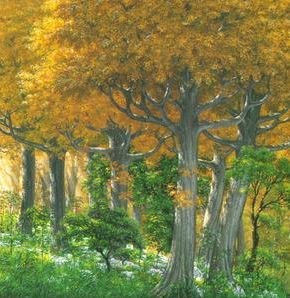 Golden
tree of Lothlorien. The mallorn was a great
and beautiful tree. Its bark was smooth and silver-grey. The leaves of
the mallorn turned golden in autumn. The golden leaves remained on the
tree through the winter and fell to cover the ground in the spring. Then
new leaves sprouted - green on top and silver underneath - and golden flowers
bloomed on the branches.
Golden
tree of Lothlorien. The mallorn was a great
and beautiful tree. Its bark was smooth and silver-grey. The leaves of
the mallorn turned golden in autumn. The golden leaves remained on the
tree through the winter and fell to cover the ground in the spring. Then
new leaves sprouted - green on top and silver underneath - and golden flowers
bloomed on the branches.
Mallorn-trees originally grew on Tol Eressea, the island off the coast of Aman in the Undying Lands. Mallorn-trees may also have grown in the realm of Gondolin in Beleriand. The Elves brought mallorn-trees to the Men of Numenor and they grew on the shores around the Bay of Eldanna.
Tar-Aldarion, the sixth King of Numenor, gave silver nuts of the mallorn as a gift to Gil-galad in Lindon in Middle-earth. The mallorn-trees did not take root in Lindon, but Galadriel brought some of the nuts to Lothlorien and planted them. Under her care, the mallorn-trees grew and flourished and Lothlorien became known as the Golden Wood.
The city of Caras Galadhon in Lothlorien was built in the branches of huge mallorn-trees. When the Fellowship came to Lothlorien in January 3019 of the Third Age, they spent the night in a flet in a mallorn-tree. The next day on Cerin Amroth, Frodo touched a mallorn and felt the vitality of the living tree.
The Fellowship was given lembas wrapped in mallorn-leaves, and Galadriel gave Sam Gamgee a box of soil that contain a silver mallorn nut. After the War of the Ring, Sam planted the nut in the Party Field where the Party Tree had once stood. In the spring of 3020 a sapling grew with silver bark and long leaves. The mallorn blossomed with golden flowers on April 6. It was one of the finest mallorn-trees in the world and people came from miles around to see it.
Names &
Etymology:
The word mallorn means "golden
tree" from mal meaning "gold" and orn meaning "tree." The
plural of mallorn is mellyrn, but mallorn-trees is
also an acceptable plural. The Quenya word is malinornë, plural
malinorni.
Sources:
The Fellowship
of the Ring: "Lothlorien," p. 349, 356-57, 363-66; "The Mirror of Galadriel,"
p. 368-69; "Farewell to Lorien," p. 387
The Two
Towers: "The White Rider," p. 92
The Return
of the King: "The Grey Havens," p. 302-303
Unfinished
Tales: "Of Tuor and His Coming to Gondolin," p. 56 (note 31); "A Description
of the Island of Numenor," p. 167-68; "The History of Galadriel and Celeborn,"
p. 253
The Silmarillion:
"Appendix - Elements in Quenya and Sindarin Names," entries for mal
and orn
Names &
Etymology:
Mallos
means
"gold blossom" from mal meaning "gold" and losse meaning
"blossom" (although this usually refers to white blossoms).
Source:
The Return
of the King: "The Last Debate," p. 151
The History
of Middle-earth, vol. V, The Lost Road and Other Writings: "The Etymologies,"
LOT(H)
entry.
Names &
Etymology:
The name Nessamelda means
"beloved of Nessa." Nessa was one of the Valar. The word melda
means "beloved, dear, sweet" in Quenya.
Sources:
Unfinished
Tales: "A Description of the Island of Numenor," p. 169
The History
of Middle-earth, vol. V, The Lost Road and Other Writings: "The Etymologies,"
entry for MEL
Nimloth was planted in the King's Court in the city of Armenelos. The tree bore fragrant flowers that bloomed at night, and in the autumn it grew fruit. In the early days of Numenor, Nimloth was cared for and honored. But as the Men of Numenor became estranged from the Elves, their gift was neglected. During the reign of Ar-Gimilzor, the twenty-third ruler, Nimloth was untended and began to decline.
Ar-Gimilzor's successor Tar-Palantir tried to repent the ways of his predecessor and he nurtured the White Tree. Tar-Palantir prophesied that when Nimloth died, the line of Kings of Numenor would end.
The next King Ar-Pharazon brought Sauron as a prisoner to Numenor, but Sauron soon corrupted the King. Sauron wanted Ar-Pharazon to cut down Nimloth because it was a reminder of the Elves and the Valar. Ar-Pharazon remembered Tar-Palantir's prophecy and he hesitated.
Isildur stole a fruit from Nimloth so that it could be preserved. He was gravely wounded by a guard and was near death. The fruit was planted, and when it began to sprout leaves Isildur fully recovered.
Ar-Pharazon cut down Nimloth and the tree was burned on the altar of a temple built by Sauron in Armenelos. A cloud of smoke covered Numenor for seven days and then it drifted slowly westward toward the Undying Lands.
In 3319 of the Second Age, Ar-Pharazon attacked the Undying Lands and Numenor was destroyed. The Faithful escaped including Isildur. He brought the seedling of Nimloth to Middle-earth where it was planted and became the White Tree of Gondor.
Names &
Etymology:
Also called Nimloth the Fair
and the White Tree. The name Nimloth means "white blossom"
in Sindarin from nim meaning "white" and loth meaning "flower."
The Quenya form of Nimloth is Ninquelótë, which
was a name used for Nimloth's ancestor Telperion.
Sources:
The Silmarillion:
"Of Eldamar," p. 59; "Akallabeth," p. 263, 268-69, 272-73, 276; "Of the
Rings of Power and the Third Age," p. 291; Index, entry for Nimloth;
"Appendix - Elements in Quenya and Sindarin Names," entries for loth
and nim
Unfinished
Tales: "The Line of Elros: Kings of Numenor," p. 223
The Return
of the King: "The Steward and the King," p. 250
Appendix
A of The Lord of the Rings: "The Numenorean Kings," p. 317
Appendix
D of The Lord of the Rings: "The Calendars," p. 388
Names &
Etymology:
Niphredil means "snowdrop."
The word niphred means "pallor, whiteness."
Sources:
The Fellowship
of the Ring: "Lothlorien," 364-66
Appendix
A of The Lord of the Rings: "The Tale of Aragorn and Arwen," p. 341
The Silmarillion:
"Of the Sindar," p. 91; Appendix: "Elements in Quenya and Sindarin Names,"
NIM
entry.
The History
of Middle-earth, vol. V, The Lost Road and Other Writings: The Etymologies,"
NIK-W
entry.
The Elves put boughs from the oiolaire on the prows of their ships as a token of their friendship with Osse and Uinen, the Maiar of the Seas. The Numenoreans had a similar practice. When a Numenorean ship set sail for Middle-earth, a branch of the oiolaire called the Green Bough of Return was placed on the prow by a woman - usually the wife or a kinswoman of the Captain. The Bough did not wither as long as it was sprayed with seawater.
The Green Bough of Return became a point of contention between the mariner Aldarion and those who opposed his voyages. First his father Tar-Meneldur forbade Aldarion's mother and sisters to place the Bough on his ship, but a woman named Erendis who loved Aldarion brought it instead.
Erendis became increasingly unhappy with Aldarion's numerous lengthy absences at Sea. On a voyage during their betrothal between 863 and 869 of the Second Age, Aldarion's ship was driven into the frozen north and the Bough withered - the first time this had ever happened. When Aldarion decided to take another voyage after his marriage to Erendis she refused to bring him the Bough.
After Aldarion became King in 883, he replaced the Bough with an image of an eagle that was given to him by Cirdan.
Names &
Etymology:
The name oiolairë means
"ever-summer" in Quenya from oio meaning "ever" and lairë
meaning "summer."
Sources:
Unfinished
Tales: "A Description of the Island of Numenor," p. 167; "Aldarion
and Erendis," p. 179-80, 187-88, 192, 205
The Silmarillion:
"Appendix - Elements in Quenya and Sindarin Names," entry for los
Appendix
D of The Lord of the Rings: "The Calendars," p. 385-86
Old Man Willow |
Old
Man Willow by John Howe
|
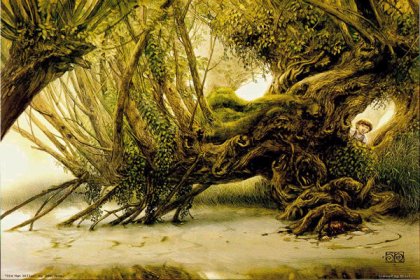 Dangerous
tree in the Old Forest. Old Man Willow
was a great, grey tree standing on the banks of the River
Withywindle. The willow's roots stretched into the water, and the branches
were long and twisted, and there were wide cracks in the trunk.
Dangerous
tree in the Old Forest. Old Man Willow
was a great, grey tree standing on the banks of the River
Withywindle. The willow's roots stretched into the water, and the branches
were long and twisted, and there were wide cracks in the trunk.
There was a malice in Old Man Willow that may have begun to form during the Great Darkness that spread through Middle-earth in the age of Morgoth, the Dark Enemy. Old Man Willow was an ancient tree, from a time when forests covered much of Middle-earth. When people began to take over the land and cut into the forests, some trees like Old Man Willow became angry and resentful.
Old Man Willow was able to exert his power to a certain extent throughout the Withywindle Valley. Most of the trees in the Old Forest were under his sway, and he could manipulate the winds around him. Although he could not walk, Old Man Willow could lure unwary travelers to him with his song.
On September 26, 3018 of the Third Age, four Hobbits entered the Old Forest. The trees and the ground of the forest seemed to lead them purposefully to the Withywindle Valley despite their intentions. As they approached Old Man Willow, they began to feel drowsy and the willow's song lulled them. Merry Brandybuck and Pippin Took went to sleep against the tree trunk and Frodo Baggins sat on one of the roots hanging out into the river and fell asleep. Only Sam Gamgee managed to resist the spell and remain awake.
Old Man Willow threw Frodo into the river and held him underwater until Sam rescued him. Frodo and Sam then discovered that two great cracks had opened in Old Man Willow's trunk and Pippin was pulled all the way inside while Merry was squeezed in halfway. Frodo kicked Old Man Willow, and the tree laughed at him. The Hobbits tried to save their friends by setting the willow on fire, but Old Man Willow became enraged and told Merry he would kill him if the fire was not put out. The whole forest was filled with anger and the winds increased.
Just in time, Tom Bombadil arrived. He sang a song to break the willow's spell, and he broke off one of the tree's branches and struck the trunk. Old Man Willow released Merry and Pippin and the forest became still once more.
Names &
Etymology:
Also called the Great Willow
and Willow-man.
Sources:
The Fellowship
of the Ring: "The Old Forest," p. 124-33; "In the House of Tom Bombadil,"
p. 137-38, 141
The Two
Towers: "Treebeard," p. 71
Party TreeTree central to Bilbo Baggins' Farewell Party. The Party Tree was located in the field south of Bag End. This field was used for Bilbo and Frodo's joint birthday party on September 22, 3001 of the Third Age. A pavillion was erected that was large enough to accommodate the Party Tree. The tree stood at the head of the main table and lanterns were hung from its branches. Bilbo stood on a chair under the tree to give his speech, during which he announced his intention to leave the Shire.When Sam Gamgee returned to the Shire after the quest in November of 3019, he was dismayed to find that the Party Tree had been chopped down and left lying in the field. In its place he planted the silver nut from the box of earth given to him by the Lady Galadriel. In the spring of 3020, the sapling of a mallorn tree emerged. It was the only mallorn west of the mountains and east of the Sea and people came from miles around to see it. Sources:
|
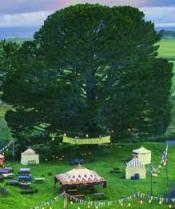 |
Pipe-weed |
Merry
smokes a pipe in the New Line film
|
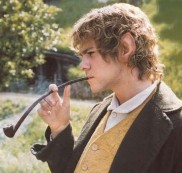 The
art of smoking pipe-weed was invented by Hobbits. Pipe-weed was put in
the bowl of a clay or wooden pipe with long stem through which one inhaled
the smoke of the burning leaves. This custom spread among Dwarves, Men,
and even Wizards, and it is still
practiced today.
The
art of smoking pipe-weed was invented by Hobbits. Pipe-weed was put in
the bowl of a clay or wooden pipe with long stem through which one inhaled
the smoke of the burning leaves. This custom spread among Dwarves, Men,
and even Wizards, and it is still
practiced today.
Most of what is known about pipe-weed comes from Herblore of the Shire by Meriadoc Brandybuck. Pipe-weed is a plant of the genus Nicotiana. The plant was probably not native to Middle-earth and may have been brought from over the Sea by the Men of Numenor. It grew abundantly in Gondor, though it was known mainly for its fragrant smell and the idea of smoking it apparently did not occur to Men. The plant was probably carried north up the Greenway, by accident or design, and came to grow around the village of Bree. The Hobbits of Bree may have been the first to smoke the plant in pipes, and the Prancing Pony in Bree became a center of the art of pipe smoking.
The first true pipe-weed was grown by Tobold Hornblower, who most likely obtained his first specimens from Bree around 2670 of the Third Age. He bred and cultivated the plant, which flourished in the warm, sheltered climate around Longbottom in the Southfarthing of the Shire. One of the most popular varieties of pipe-weed, Old Toby, was named after him. Longbottom Leaf and Southern Star were two other popular types of leaf of the Shire, while Southlinch was a variety grown in Bree.
During their long journey, the members of the Fellowship frequently took comfort in smoking pipes. Strider the Ranger was smoking a pipe when Frodo first saw him. Gandalf smoked to help himself think when he was uncertain of the way to take in Moria. Sam remembered to pack pipe-weed when the Fellowship left Rivendell (though he forgot rope); later, near Mordor, he dreamed he was searching for his pipe and realized he had no weed left.
Merry and Pippin were able to replenish their supply from a cache of Longbottom Leaf they found in the storerooms of Isengard. They shared their discovery with the Three Hunters, who had at last caught up to them. At their first meeting, Merry promised to tell King Theoden about the history of smoking, but he never got the chance. After the Battle of the Pelennor Fields, where the King was slain, Merry thought he might never smoke again, but Aragorn told him to have a pipe in memory of his liege.
The mystery of the pipe-weed found at Isengard was solved when the Hobbits returned home: Saruman had been dealing with Lotho Sackville-Baggins. Lotho had begun by selling pipe-weed from his lands in the Southfarthing but had expanded his business interests. Soon there was no leaf to be had by Hobbits in the Shire. Rough-looking Men started to take over and then Saruman himself arrived. But after the Scouring of the Shire, in the year 1420 S.R., there was a bountiful pipe-weed harvest and things returned to normal.
Names &
Etymology:
Also called leaf and weed;
called in Gondor sweet galenas and westmansweed.
Sources:
The Fellowship
of the Ring: "Prologue: Concerning Pipe-weed," p. 17-18; "At the Sign
of the Prancing Pony," p. 168; "The Ring Goes South," p. 293; "A Journey
in the Dark," p. 327
The Two
Towers: "The Road to Isengard," p. 163-4; "Flotsam and Jetsam," p.
165-9; "Journey to the Cross-Roads," p. 308
The Return
of the King: "The Battle of the Pelennor Fields," p. 118; "The Houses
of Healing," p. 145-7; "Many Partings," p. 262; "Homeward Bound," p. 270;
"The Scouring of the Shire," p. 279, 291-2; "The Grey Havens," p. 304
Unfinished
Tales: "The Hunt for the Ring - Concerning Gandalf, Saruman and the
Shire," p. 348-52
When Turin and his band of outlaws first came to Amon Rudh, they saw the red seregon on the hilltop by the light of the setting sun. An outlaw named Androg said: "See! There is blood on the hill-top." Turin replied, "Not yet." (UT, p. 99)
Around 489 of the First Age, Mim the Petty-Dwarf betrayed the location of Turin's hideout to Morgoth's spies. Orcs captured Turin and killed his men, and their blood stained the hilltop where the seregon grew.
Names &
Etymology:
The name seregon means "blood
of stone" in Sindarin from sereg meaning "blood" and gon
from gond meaning "stone." It was so named because it grew on stony
ground and had red flowers.
Sources:
The Silmarillion:
"Of Turin Turambar," p. 203, 206 ; "Appendix - Elements in Quenya and Sindarin
Names," entries for gond and sereg
Unfinished
Tales: "Narn I Hin Hurin," p. 99, 148 note 14
The Children
of Hurin: "Of Mim the Dwarf," p. 128
Simbelmynë |
Simbelmyne
in the New Line film
|
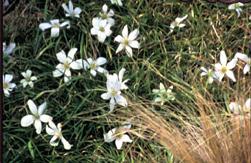 Flower
of Rohan. Simbelmyne was a small white flower
that blossomed throughout the year. It grew on land where the dead were
buried, particularly upon the barrows of the Kings of Rohan. The flowers
were said to grow thickest on the ninth mound in the first row, where Helm
Hammerhand was buried.
Flower
of Rohan. Simbelmyne was a small white flower
that blossomed throughout the year. It grew on land where the dead were
buried, particularly upon the barrows of the Kings of Rohan. The flowers
were said to grow thickest on the ninth mound in the first row, where Helm
Hammerhand was buried.
Two flowers are named in Unfinished Tales that appear to be similar to - or possibly the same as - simbelmyne. In Gondolin, Tuor saw white flowers called uilos, or Evermind, that bloomed in all seasons. When Cirion and Eorl climbed Halifirien, the Hill of Awe, they saw white flowers called alfirin on the tomb of Elendil. However, there is a flower named alfirin mentioned by Legolas in The Return of the King that appears to be a different type of flower. See the entry for Alfirin above.
Tolkien envisioned simbelmyne to be "an imagined variety of anemone, growing in the turf like Anemone pulsatilla, the pasque-flower, but smaller and whiter like the wood anemone." (Nomenclature, p. 198)
Names &
Etymology:
Called Evermind in Common
Speech.
In Old English, symbel or symel means "ever, always" and myne means "mind, memory."
Uilos may mean "ever-snow-white" or "ever-blossoming" in Sindarin. From the Quenya oi meaning "ever" and either olosse meaning "snow, snow-white" or losse meaning "blossom" (usually referring to white blossoms).
Alfirin means "immortal."
Sources:
The Two
Towers: "The King of the Golden Hall," p. 111
Appendix
A of The Lord of the Rings: "The House of Eorl," p. 348
Unfinished
Tales: "Of Tuor and His Coming to Gondolin," p. 48, 55 (note 27); "Cirion
and Eorl," p. 303-4, 316 (note 38)
Old English
Glossary at Beowulf in Cyberspace
The History
of Middle-earth, vol. V, The Lost Road and Other Writings: "The Etymologies,"
OY
and LOT(H) entries.
Letters
of J.R.R. Tolkien: Letter #310 (alfirin definition)
"Nomenclature
of The Lord of the Rings," entry for Evermind
Names &
Etymology:
Varda was the greatest Queen
of the Valar. The name Vardarianna may contain the Quenya words
ría
or ríë meaning "wreath" and "crown" and the word anna
meaning "gift."
Sources:
Unfinished
Tales: "A Description of Numenor," p. 167
The History
of Middle-earth, vol. V, The Lost Road and Other Writings: "The Etymologies,"
entries for ANA and RIG
The History
of Middle-earth, vol. XII, The Peoples of Middle-earth: "The Shibboleth
of Feanor," p. 347 (RIG)
White Tree of Gondor |
Top:
Decipher
Card of a sapling of the White Tree
Below: A Guard of the Citadel and the White Tree in the New Line film |
| Symbol of Gondor.
The White Tree grew from a sapling that Isildur
brought from Numenor, which in turn was descended
from a tree that had come from the Undying Lands. Many years after the
line of Kings ended, the White Tree withered and died. The Dead Tree stood
in the Court of the Fountain until Aragorn, King
Elessar, found a sapling and the White Tree bloomed in Minas
Tirith once more.
The White Tree was descended from Galathilion, a tree created by Yavanna, the Vala of growing things. She made Galathilion in the image of Telperion, one of the Two Trees of Valinor. A seedling of Galathilion called Celeborn was planted on the island of Tol Eressea, and from this tree the Elves took another seedling and presented it to the Men of Numenor. The tree that grew from this seedling was called Nimloth. Sauron counselled Ar-Pharazon, the King of Numenor, to cut Nimloth down. When Isildur learned of this, he stole a fruit from the tree and it was planted in secret. Isildur was gravely wounded during the raid, but when the fruit sprouted and unfurled its first leaf, he awoke and his wounds were healed. The seedling that grew from this fruit was saved from the Downfall of Numenor in 3319 of the Second Age. Isildur planted it in his new stronghold of Minas Ithil and it became the first of the White Trees of Gondor. Sauron seized Minas Ithil in 3429 and burned the White Tree, but Isildur escaped with another seedling. In the year 2 of the Third Age, Isildur planted the seedling in Minas Anor in memory of his brother Anarion who had been killed in the War of the Last Alliance. The White Tree grew in the Court of the Fountain in the highest level of Minas Anor, which was later called Minas Tirith. The tree had long leaves that were dark green on top and silver underneath and it blossomed with white flowers. The emblem of the Kings was a black field bearing the White Tree symbolizing Gondor beneath Seven Stars and a Crown that were the tokens of the Heirs of Elendil. In 1636 of the Third Age, the Great Plague came to Gondor and King Telemnar died. The White Tree also withered and died, but Telemnar's nephew Tarondor replanted a seedling of the tree in the Citadel in 1640. The line of Kings failed in 2050, and afterwards the White Tree bore fewer fruits and flowers and it began to age. In 2872, Belecthor II, the Steward of Gondor, died and the White Tree withered and died as well. This time no seedling was found and the Withered Tree was left to stand in the Court of the Fountain until the return of the King to Gondor. When Aragorn came to Minas Tirith on March 15, 3019, he unfurled a banner made by Arwen that bore the emblem of the White Tree of Gondor and the Seven Stars and Crown of the King. After the War of the Ring, Aragorn was crowned King of the Reunited Kingdom of Gondor and Arnor. On June 25, Aragorn and Gandalf climbed Mount Mindolluin behind Minas Tirith and there Aragorn found a sapling of the White Tree that was about three feet tall and less than seven years old. It had most likely grown from a fruit that had been planted long ago and had lain dormant for many years. The Withered Tree was taken down and laid to rest in the Silent Street where the Kings and Stewards were buried, and the sapling was planted in its place. The White Tree flowered in the Court of the Fountain and it was seen as a sign of rebirth and renewal for the Kingdom of Gondor. Note: The date of Belecthor's death and the withering of the White Tree is incorrectly given as 2852 in "The Tale of Years." Names &
Etymology:
Sources:
|

|
Names &
Etymology:
The name yavannamírë
means "jewel of Yavanna" in Quenya. Yavanna was the Vala of growing things.
The word mírë means "jewel."
Sources:
Unfinished
Tales: "A Description of the Island of Numenor," p. 167; Index entry
for yavannamire
All entries are Copyright © by the Thain from former tuckborough.net. Please contact me if you are Thain or know anything about how to contact the original author.
2003-2011, The Thain's Book - thainsbook.minastirith.cz
- e-mail: thain at tuckborough.net